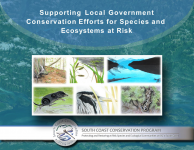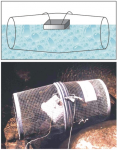Facilitating the protection and restoration of species and ecosystems at risk on BC’s South Coast
Resources
Diversity by Design is intended to fulfill an identified need for science-based guidance for stewards, land managers, and practitioners involved in habitat restoration and management activities that either directly target or indirectly affect species and ecological communities at risk on BC’s South Coast. It is increasingly recognized that restoration projects should not be only focused on a single species but should employ a “multi-species approach” in order to...
The South Coast is the first region to implement actions that integrate recommendations from the discussion paper Working Together to Protect Species at Risk: Strategies Recommended by Local Government to Improve Conservation on Municipal, Regional and Private Lands in British Columbia developed by the provincial Species and Ecosystems at Risk and Local Governments Working Group (SEAR LGWG). While local governments have many of the tools needed to achieve...
A number of guidelines and best practices have been developed in BC as well as nationally or internationally for the conservation and recovery for species at risk, rare plants and ecosystems. Not all of these methods or techniques are tied to regulatory requirements but they are based on the best available science on species at risk, protecting their critical habitat needs or maintaining the ecological integrity of local landscapes. The SCCP has gathered the best...
So what is citizen science? "Broadly defined, citizen science is a form of research collaboration that involves volunteers in producing authentic scientific research. Drastically simplified, citizen science is research accomplished by engaging humans as “sensors” to collect scientific data or as “processors” to manipulate scientific data or to solve data analysis problems. Involving people beyond professional scientists in a project enables unique new research,...
There have been a number of efforts to map out the ecological values of the South Coast's landscapes from the historic vegetation surveys of the Lower Fraser from the 1890's to the soil maps of southern BC. Captured here is a sampling of the resources out there representing a snapshot in time of the Lower Mainland's past ecological capital, providing a reminder of how much has changed and been lost over just a couple of generations.
Where available we have also...
Why inventory and monitor species and ecosystems at risk? Without such activities we would be unable to determine the status of various species (how many there are, the health of individuals, breeding success etc.). This data is critical to improving management decisions.
It is also important to create a roadmap for identifying how or where the information you gather through monitoring is contributing or will contribute to relevant conservation actions. It is...
At the foundation of species at risk conservation in BC and Canada is the compilation of information around the ecology of a species, its critical habitat needs, the threats that have put it at risk and the recommendations for its recovery. But before a species can even be listed, it must be proposed for listing. In Canada this is done through the independent science body known as the Committee on the Status of Endangered Wildlife in Canada (COSEWIC). Originally...
Species at Risk Conservation in Canada could not be successful without recognizing and integrating the perspectives and knowledge of Indigenous communities. SARA recognizes this explicitly by embedding a commitment to First Nations collaboration in the Act's preamble stating that “…the traditional knowledge of the aboriginal peoples of Canada should be considered in the assessment of which species may be at risk and in developing and implementing recovery measures...
Species at Risk in the Classroom ("SARitc" for short) is the SCCP's unique curriculum resource made for formal and informal educators on the South Coast! Feel free to download the modules below and explore how you can link conservation and nature exploration objectives to your curriculum or environmental education programming. With the new BC Curriculum the time is right more than ever to connect your students to nature-based programs and resources.
As part of...










